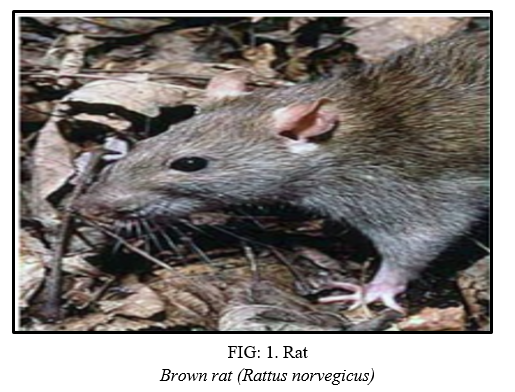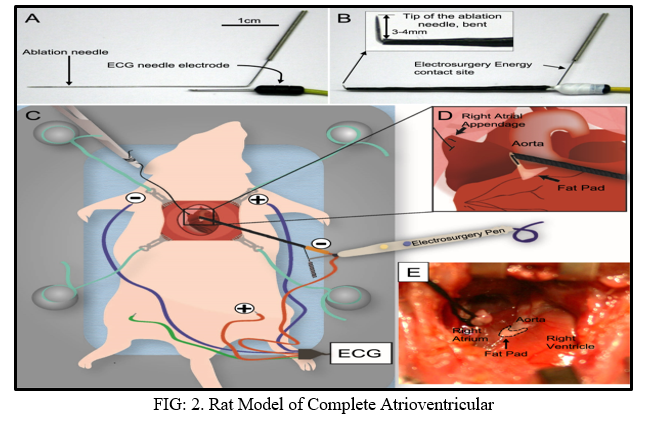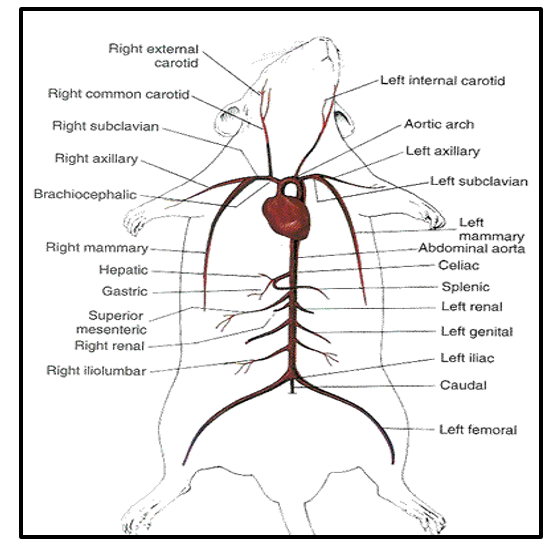Ijraset Journal For Research in Applied Science and Engineering Technology
- Home / Ijraset
- On This Page
- Abstract
- Introduction
- Conclusion
- References
- Copyright
Evaluation of Cardiovascular Experiment Animal
Authors: Kirtane Ramesh Kirtane, Prof. Akhare. T. P., Dr. Hingane L. D.
DOI Link: https://doi.org/10.22214/ijraset.2021.39577
Certificate: View Certificate
Abstract
In vivo models of myocardial infarction induced by coronary artery ligation in rats usually suffer from high early mortality and a low rate of induction. This study investigated the time course initiation of chronic myocardial infarction in albino rats and the possibility of reducing early mortality rate due to myocardial infarction by modification of the surgical technique. CAL was carried out by passing the suture through the pericardial layer around the midway of the left anterior descending coronary artery including a small area of the myocardium to avoid mechanical damage to the heart geometry. In addition, the role of endothelin-1 in rat heart with congestive heart failure was critically assessed. Time course initiation experiments were designed by sacrificing the animals at different time intervals and by carrying out physiological, biochemical, histopathological, electron microscopical and immunohistochemical studies. Specific markers of myocardial injury, viz. cardiac troponin-T, high sensitivity C-reactive protein, lactate dehydrogenase and fibrinogen were measured at different time points. Serum marker enzymes and activities of lysosomal hydrolases were found to be elevated on the eighth day post-ligation. Histopathological studies demonstrated focal areas showing fibrovascular tissue containing fibroblasts, collagenous ground substance and numerous small capillaries replacing cardiac muscle fibers. Transmission electron micrographs exhibited mitochondrial changes of well-developed irreversible cardiac injury, viz. swelling, disorganization of cristae, appearance of mitochondrial amorphous matrix densities, and significant distortion of muscle fibers and distinct disruption of the intercalated discs. Immune blotting studies confirmed the presence of alpha 2-macroglobulin which supported the inflammatory response. The severity of the CMI was inferred by the measurement of the level of ET-1 in plasma and left ventricle which was significantly higher in the CMI rats than in the sham-operated rats. Immunohistochemical studies at different time intervals showed that there was a significant immunoexpression of ET-1 on the eighth day post-ligation. This study conclusively showed that ligation of left anterior descending artery minimised mortality and ET-1 was expressed during CMI.
Introduction
I. INTRODUCTION
Rats are various medium-sized, long-tailed rodents. Species of rats are found throughout the order Rodentia, but stereotypical rats are found in the genus Rattus. Other rat genera include Neotoma (pack rats), Bandicota (bandicoot rats) and Dipodomys (kangaroo rats). Rats are typically distinguished from mice by their size. Usually the common name of a large muroid rodent will include the word "rat", while a smaller maid's name will include "mouse". The common terms rat and mouse are not taxonomically specific. There are 56 known species of rats in the world. The best-known rat species are the black rat (Rattus rattus) and the brown rat (Rattus norvegicus). This group, generally known as the Old World rats or true rats, originated in Asia. Rats are bigger than most Old World mice, which are their relatives, but seldom weigh over 500 grams in the wild. The term rat is also used in the names of other small mammals that are not true rats. Examples include the North American pack rats (aka wood rats and a number of species loosely called kangaroo rats. Rats such as the bandicoot rat (Bandicota bengalensis) are murine rodents related to true rats but are not members of the genus Rattus. Male rats are called bucks; unmated females, does, pregnant or parent females, dams; and infants, kittens or pups. A group of rats is referred to as a mischief. The common species are opportunistic survivors and often live with and near humans; therefore, they are known as commensals. They may cause substantial food losses, especially in developing countries. However, the widely distributed and problematic commensal species of rats are a minority in this diverse genus. Many species of rats are island endemic, some of which have become endangered due to habitat loss or competition with the brown, black, or Polynesian rat. Wild rodents, including rats, can carry many different zoonotic pathogens, such as Leptospira, Toxoplasma gondii, and Campylobacter. The Black Death is traditionally believed to have been caused by the microorganism Yersinia pestis, carried by the tropical rat flea which preyed on black rats living in European cities during which these rats were used as transport hosts. Rats become sexually mature at age 6 weeks, but reach social maturity at about 5 to 6 months of age. The average lifespan of rats varies by species, but many only live about a year due to predation the black and brown rats diverged from other Old World rats in the forests of Asia during the beginning of the Pleistocene.
II. RAT

Scientific classification
- Kingdom: Animalia
- Phylum: Chordata
- Class: Mammalia
- Clade: Simplicidentata
- Order: Rodentia
III. HISTORY
Rattus norvegicus the “Norway Rat” is thought to have originated in temperate Asia. It expanded into Europe in the 8th Century and eventually into the Americas in the late 1700’s. By now it has spread worldwide. The name of “Norway rat” has no particular geographic significance, although they are believed to have migrated to Western Europe via the Norwegian Peninsula.
Rattus rattus the “Black rat”, “Ship rat”, “Roof rat” spread from Southeast Asia into Europe around the 12th Century, reaching the Americas in the 16th Century. Largely responsible for the spread of Bubonic plague (“Black death”) to Europe in the 14th century (it killed about a quarter of the European population).
R. rattus is less aggressive than Norway rats and have been replaced by Norway rats in most areas of the world except areas with warmer climates. Not used in research.
R. norvegicus was probably the first mammalian species domesticated for scientific purposes the spread of both species was facilitated by their sharing of the same habitat with man.
In the 19th Century, rats were used in the “sport” of rat baiting.
Rat baiting was based on the time required for terrier dogs to kill 100-200 rats.
OTHER RATS OCCASIONALLY USED
Family Genus Species
Muridae Rattus R. norvegicus
R. rattus
Cricetidae Sigmodon S.hispidus (cotton rat)
Oryzomous O.palustris (Rice Rat)
Neotoma N.spp (Wood Rat)
Mystromys M.albicaudatus (white Tailed Rat)
IV. ANIMAL MODEL USED IN RESEARCH
A. Used for Research Since mid 1800’s
Philipeaux studied adrenalectomized white rats in France in 1856 with published reports of nutritional and breeding research.
Neuroanatomical studies by Henry Donaldson at the University of Chicago in the early 1890’s represented the first known experimental use of rats in the USA. He later established Wistar Institute in Philadelphia that will have a major role in the development of the rat as an important laboratory animal similar to the impact the Jackson laboratory had on the development of the laboratory mouse.
The Wistar bloodline has contributed more strains of rats than any other line.
B. Wild and Laboratory Rats Differences
- Differences are noted in size and function of organs, reproductive performance, and behavior.
- Adrenals are smaller, especially the cortex in laboratory rats.
- Ovaries, testes, and secondary sex glands are the same size but mature earlier and function continuously in laboratory rats.
- Laboratory rats mature earlier, and are more prolific.
- Laboratory rats are shorter lived.
- Two to three years for the lab rat as compared to four to five years for wild rats.
- Laboratory rats overall have a smaller body size.
V. MATERIALS AND METHODS
A. Hypertension
Human hypertension is usually a slowly-developing disorder of middle to old age which predisposes to the cardiovascular disorders that cause most of the morbidity and mortality in the elderly.
The incidence and sequelae of hypertension vary markedly by patient subgroup, particularly by gender and race the prevalence of hypertension is higher in men than age-matched premenopausal women, but similar for 70-year-old men and postmenopausal women. Human hypertension is probably triggered by environmental influences such as increased salt intake, obesity and lack of exercise acting on a genetic predisposition Physiological levels of oestrogen exert a cardioprotective effect, with postmenopausal women being two to three times less likely to develop heart disease if receiving oestrogen replacement therapy
The specific genes responsible for hypertension have not been identified but epidemiological, family and twin studies suggest that a substantial portion of the phenotypic variation in blood pressure is genetically determined. Long-term hypertensives often have other cardiovascular risk factors including elevated cholesterol levels, reduced high-density lipoproteins, diabetes, left ventricular hypertrophy and obesity Untreated hypertensives present acutely with stroke, coronary artery disease leading to myocardial infarction or acute renal failure. Most patients have essential hypertension, where no cause can be determined, which leads to many abnormalities in the physiological regulatory systems for blood pressure including neurotransmitters and humoral factors with abnormalities of the cardiac and vascular smooth muscle and endothelium. It is often unclear which of these changes are causative and which are secondary to the hypertension. These are the characteristics of human hypertension which rat models should mimic. Many studies have been undertaken using rat models of hypertension and heart failure since an earlier comprehensive review.
Our review of hypertension is mainly of the rat models of systemic hypertension, but some consideration of renal and pulmonary hypertension is inevitable. Excessive vasoconstriction, commonly involving the endogenous peptides, angiotensin II and endothelin, or deficient vasodilatation, often involving nitric oxide are common mechanisms in hypertension, whether defined as systemic, pulmonary or renal.
B. Systemic Hypertension
Spontaneously hypertensive and stroke-prone rats
The most commonly used model of cardiovascular disease, with over 4000 Medline references in the last 10 years, is the Spontaneously Hypertensive rat often with the Wistar Kyoto rat as the normotensive control. SHRs are descendants of an outbred Wistar male with spontaneous hypertension from a colony in Kyoto, Japan, mating with a female with an elevated blood pressure, and then brother×sister mating continued with selection for spontaneous hypertension, defined as a systolic blood pressure of over 150 mm Hg persisting for more than one month.
From 1968, this inbred strain of SHRs was further developed in the USA.
The various colonies of SHR are pre-hypertensive for the first 6–8 weeks of their lives with systolic blood pressures around 100–120 mmHg. and then hypertension develops over the next 12–14 weeks.
As in humans, hypertension develops more rapidly and becomes more severe in male than female SHR
In vivo studies have shown that, in the early stages of hypertension, SHRs have an increased cardiac output with normal total peripheral resistance. As the SHR progresses into the established hypertension state, the cardiac output returns to normal and the hypertrophied blood vessels produce an increase in the total peripheral resistance.
The male SHR is commonly used as a model of established human hypertension, for example to define hypertension-induced changes in signalling mechanisms.
Experience with other genetic hypertensive strains of rats has been limited by comparison with the SHR yet these strains may be useful in determining the genes involved both in hypertension and in associated risk factors such as an elevated fibrinogen; some examples are the New Zealand.

C. Heart failure
Spontaneously hypertensive rats with failure
The SHR-F has been long known to have many similarities to human essential hypertension-induced heart failure including the important feature that impaired myocardial performance is a late feature that precedes overt failure. More recently, Bing et al. have shown that at 18–24 months, 57% of the SHRs have cardiac decompensation and they have further compared these animals to age-matched SHR without failure and Wistar Kyoto normotensive rats. The SHR-F can be identified outwardly as they become less active and well groomed and develop occasional tachypnoea which becomes more persistent and turns into laboured respiration. Left, but not right, ventricular hypertrophy is a feature of the young adult SHR while hypertrophy of the right ventricle is a reliable marker in the cardiac decompensation of failure. Pleuropericardial effusions and atrial thrombi are also commonly observed in SHR-F. Echocardiography was used to show that the SHR-F had increased diastolic and systolic volumes and decreased ejection fractions with cardiac catheterization demonstrating an increased left ventricular end-diastolic pressure.
Increased apoptosis of cardiomyocytes is observed in the SHR-F compared with the SHR-NF.
The SHR-F model is a good model of human hypertension-induced heart failure as these conditions have many features in common, and thus will allow measurement of relevant cardiac, biochemical and haemodynamic parameters. In the SHR, failure occurs around 2 years of age and may therefore be compromised by the effects of ageing.
This may make the interpretation of the rat data more difficult but it could also be argued that, since human heart failure is also commonly complicated by the effects of ageing, the aged SHR is the more realistic model. As this is a non-
Intervention model, there is no need for skilled technical assistance or mortality associated with surgery. The major disadvantage of the SHR-F model is the extended time frame and therefore increased costs of these experiments compared with other models of heart failure.

VI. CARDIOVASCULAR
- Heart rate = 300-500 beats per minute
- Systolic blood pressure = 116 mm Hg
- Diastolic blood pressure = 90 mm hg
- Blood Volume = 6 ml per 100 grams of body weight Respirations: = 85 breaths per minute Renal: Proteinuria is normal in the rat.
|
Experimental model |
Description |
|
Apolipoprotein E knockout (ApoE−/−) mice |
Apolipoprotein E a constituent of lipoprotein responsible for packaging cholesterol and other fats and carrying them through the bloodstream, is inactivated by gene targeting. They exhibit a higher total plasma cholesterol concentration of 11 mM compared to 2 mM in their parent C57BL/6 mice. |
|
LDL receptor knockout (LDLR−/−) mice |
LDL receptor is a cell surface receptor in liver cells that mediates the endocytosis of apoE to clear cholesterol-abundant LDL particles from the circulation. Total plasma cholesterol levels increase twofold compared to those of wild-type, owing to a seven- to nine fold increase in intermediate density lipoproteins (IDL) and LDL without a significant change in HDL |
|
Scavenger receptor class B member 1 knockout (SR-BI KO) mice |
Scavenger receptor class B member 1 functions in facilitating the uptake of cholesterol from HDL in the liver. It plays a key role in determining the levels of plasma cholesterol . Heterozygous and homozygous mutants show 31% and 125% increase, respectively, in plasma cholesterol concentrations. |
|
db/db mice |
OB-R is a high affinity receptor for leptin, an important circulating signal for the regulation of feeding, appetite, and body weight. Fatty acid oxidation rates are progressively higher in db/db mice in parallel with the earlier onset and greater duration of hyperglycemia |
Conclusion
Progress in cardiovascular disease control requires understanding of the pathogenesis of the disease and testing of potential therapies, both experimentally and clinically. Experimental animal models, particularly murine species, have been a useful tool in this regard. The ideal animal model of cardiovascular disease should be representative to human conditions metabolically and pathophysiologically. The development of genetically modified animal models has enabled researchers to manipulate a specific target, the role of which in pathogenesis may be subsequently established. This has led to the discovery of a vast spectrum of potential targets for ameliorative intervention. While the use of animal models has undeniably offered novel insights into different important aspects of a disease, still there are no species which are absolutely suitable for all studies, given the multifactorial nature of cardiovascular disease. Therefore, it is of utmost importance to choose an appropriate model to study different parts of cardiovascular disease. Otherwise, many exciting research findings may fail when translating into human studies. An agreement on appropriate experimental models for the study of different facades of cardiovascular disease would be a viable and effective strategy to further the advancement in this field.
References
[1] https://www.gov.uk/government/statistics/statistics-of-scientific-procedures-on-living-animals-great-britain-2013. [2] Franklin T. B., Russig H., Weiss I. C., et al. Epigenetic transmission of the impact of early stress across generations. Biological Psychiatry. 2010;68(5):408–415. doi: 10.1016/j.biopsych.2010.05.036. [PubMed] [CrossRef] [Google Scholar] [3] Erickson Z. T., Falkenberg E. A., Metz G. A. S. Lifespan psychomotor behaviour profiles of multigenerational prenatal stress and artificial food dye effects in rats. PLoS ONE. 2014;9(6) doi: 10.1371/journal.pone.0092132.e92132 [PMC free article] [PubMed] [CrossRef] [Google Scholar] [4] The Chimpanzee Sequencing and Analysis Consortium. Initial sequence of the chimpanzee genome and comparison with the human genome. Nature. 2005;437(7055):69–87. doi: 10.1038/nature04072. [PubMed] [CrossRef] [Google Scholar] [5] Mural R. J., Adams M. D., Myers E. W., et al. A comparison of whole-genome shotgun-derived mouse chromosome 16 and the human genome. Science. 2004;296(5573):1661–1671. [PubMed] [Google Scholar] [6] Katzung B. G., Masters S., Trevor A. Basic and Clinical Pharmacology. 12th. Norwalk, Conn, USA: Appleton & Lange; 2012. [Google Scholar] [7] Russell W. M. S., Burch R. L. The Principles of Humane Experimental Technique. London, UK. Methuen: 1959. http://altweb.jhsph.edu/pubs/books/humane_exp/het-toc#. [Google Scholar] [8] Emerson M. Refinement, reduction and replacement approaches to in vivo cardiovascular research. British Journal of Pharmacology. 2010;161(4):749–754. doi: 10.1111/j.1476-5381.2010.00959.x. [PMC free article] [PubMed] [CrossRef] [Google Scholar] [9] Kilkenny C., Browne W., Cuthill I. C., Emerson M., Altman D. G. Animal research: reporting in vivo experiments: the ARRIVE guidelines. British Journal of Pharmacology. 2010;160(7):1577–1579. doi: 10.1111/j.1476-5381.2010.00872.x. [PMC free article] [PubMed] [CrossRef] [Google Scholar] [10] Hooijmans C. R., Leenaars M., Ritskes-Hoitinga M. A gold standard publication checklist to improve the quality of animal studies, to fully integrate the three Rs, and to make systematic reviews more feasible. Alternatives to Laboratory Animals. 2010;38(2):167–182. [PubMed] [Google Scholar].
Copyright
Copyright © 2022 Kirtane Ramesh Kirtane, Prof. Akhare. T. P., Dr. Hingane L. D.. This is an open access article distributed under the Creative Commons Attribution License, which permits unrestricted use, distribution, and reproduction in any medium, provided the original work is properly cited.

Download Paper
Paper Id : IJRASET39577
Publish Date : 2021-12-22
ISSN : 2321-9653
Publisher Name : IJRASET
DOI Link : Click Here
 Submit Paper Online
Submit Paper Online

